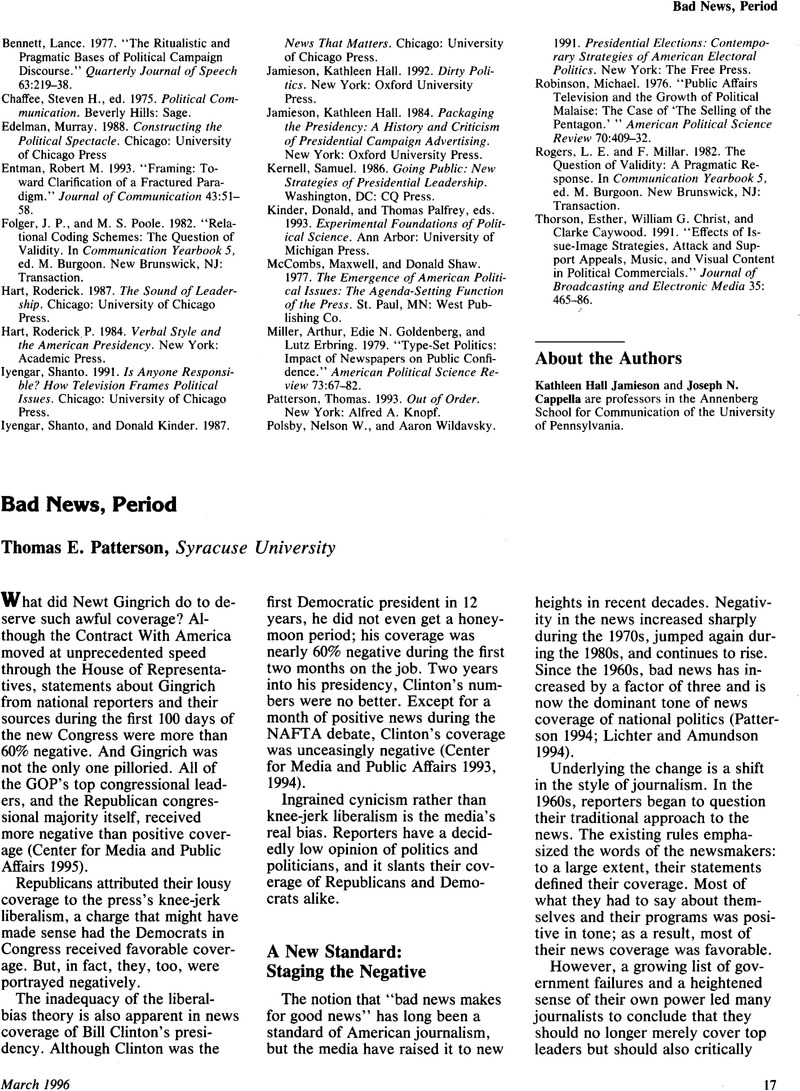Crossref Citations
This article has been cited by the following publications. This list is generated based on data provided by Crossref.
Mervin, David
1996.
Does American democracy really work?.
Democratization,
Vol. 3,
Issue. 4,
p.
530.
Traut, Carol Ann
1997.
China and the 1995 United Nations conference on women.
Journal of Contemporary China,
Vol. 6,
Issue. 16,
p.
581.
Groeling, Tim
and
Kernell, Samuel
1998.
Is Network News Coverage of the President Biased?.
The Journal of Politics,
Vol. 60,
Issue. 4,
p.
1063.
Traut, Carol Ann
1999.
Policy implementation in an international setting: a case study of China and the 1995 united nations conference on women.
International Journal of Public Administration,
Vol. 22,
Issue. 2,
p.
285.
Filzmaier, Peter
and
Plasser, Fritz
2001.
Wahlkampf um das Weiße Haus.
p.
195.
Nicholson, Stephen P.
Segura, Gary M.
and
Woods, Nathan D.
2002.
Presidential Approval and the Mixed Blessing of Divided Government.
The Journal of Politics,
Vol. 64,
Issue. 3,
p.
701.
Baum, Matthew A.
2004.
How Public Opinion Constrains the Use of Force: The Case of Operation Restore Hope.
Presidential Studies Quarterly,
Vol. 34,
Issue. 2,
p.
187.
Baum, Matthew A.
2005.
Talking the Vote: Why Presidential Candidates Hit the Talk Show Circuit.
American Journal of Political Science,
Vol. 49,
Issue. 2,
p.
213.
Warren, Mark E.
2006.
Democracy and Deceit: Regulating Appearances of Corruption.
American Journal of Political Science,
Vol. 50,
Issue. 1,
p.
160.
Baum, Matthew
and
Groeling, Tim
2007.
Crossing the Water's Edge: Elite Rhetoric, Media Coverage and the Rally-Round-the-Flag Phenomenon, 1979-2003.
SSRN Electronic Journal,
2007.
Postmoderne Nachrichtenlogik.
p.
331.
Hansen, Kasper M.
and
Pedersen, Rasmus Tue
2008.
Negative Campaigning in a Multiparty System.
Scandinavian Political Studies,
Vol. 31,
Issue. 4,
p.
408.
2008.
Politikwissenschaft.
p.
363.
Branton, Regina P.
and
Dunaway, Johanna
2009.
Slanted Newspaper Coverage of Immigration: The Importance of Economics and Geography.
Policy Studies Journal,
Vol. 37,
Issue. 2,
p.
257.
2010.
L’analyse des politiques publiques.
p.
387.
Magen, Clila
2013.
The Israeli Mossad and the media: Historical and theoretical perspectives.
Public Relations Review,
Vol. 39,
Issue. 2,
p.
111.
De Cillia, Brooks
and
McCurdy, Patrick
2020.
No Surrender. No Challenge. No Protest Paradigm: A Content Analysis of the Canadian News Media Coverage of the “Yellow Vest Movement” and the “United We Roll Convoy”.
Canadian Review of Sociology/Revue canadienne de sociologie,
Vol. 57,
Issue. 4,
p.
656.
Shabahang, Reza
Hwang, Hyeyeon
Thomas, Emma F.
Aruguete, Mara S.
McCutcheon, Lynn E.
Orosz, Gábor
Hossein Khanzadeh, Abbas Ali
Mokhtari Chirani, Benyamin
and
Zsila, Ágnes
2024.
Doomscrolling evokes existential anxiety and fosters pessimism about human nature? Evidence from Iran and the United States.
Computers in Human Behavior Reports,
Vol. 15,
Issue. ,
p.
100438.



